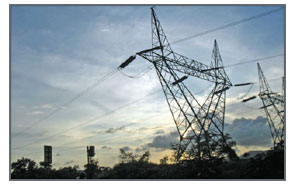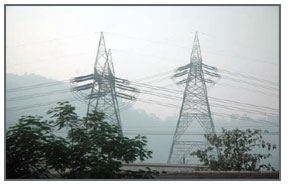
The government has set a target to
add 1 lakh mw of generation
capacity in the XII Five-year
Plan period to fulfill its promise of
'Power to All'. For the expected boost in
the power sector, major policy changes
at the Central and the state level is the
next step forward. This should be along
with continued push at reform and
greater private participation in
generation, transmission and
distribution of power.
While looking at adding generating
capacity of 1 lakh mw, the most
essential block that needs to be put in
place is efficient transmission
capacity and network. The
transmission grid is a critical
component for reliable and safe
delivery of power from generating
stations to distribution networks.
The Central Transmission Utility
(CTU) was set up with the objective to
create a National Grid connecting all
state and regional grids in the
country. In earlier days, electricity
was supplied by generating stations
to load centres. However, with
increased power generation capacity,
the need for a National Grid was felt
for bulk power transmission between
the five major regions of India with
minimal losses.

India now plans to connect all
regional grids into a National Grid by
2014 to improve transmission of
power across the country. The
Rs.1.4-trillion plan to build the grid
to increase country's inter-regional
transmission capacity and enhance
transfer of power from surplus
regions to deficit areas is now afoot.
As on January 2011, India's power
transfer capacity stood at 20,750
mw, falling short of the 11th Plan
Period target of 32,650 mw. India
now has a total length of around
240,000 ckm of transmission lines.
Power transmission in India was
restricted to Central and state
utilities until the year 2006. Though,
the Electricity Act, 2003 opened
doors for private sector participation
in the power sector, private
investment in transmission started
only in 2006. Private sector
investment was allowed in the form of
100 per cent private equity or as a 74
per cent JV with the CTU. The huge
capital required for building efficient
transmission infrastructure has
attracted numerous domestic and international players. Total outlay for transmission sector in
the XII Plan is estimated at Rs.2.4 trillion.
Private sector participation in transmission is inevitable with
such huge potential for investment. Increase in power generation
capacity will result in steady order flows for T&D, providing
ample opportunities for private players. Partnership between
private players and Central/state utilities will ensure efficient
and optimum operation of the transmission system thereby
reducing system losses, voltage fluctuations and power pilferage.
The PPP model is ideal for projects that are too large for a
private developer or an entity to handle individually. The
developer can put in required investment, offering low capital
costs and bring in efficiencies as a financier, project manager and
technology supplier. PPPs offer stable annuity income for the
bidding entity in addition to captive orders of EPC, thereby
providing additional and sustainable revenue streams.
However, as the private player may not have the requisite skill
needed for the project in the initial stages, involvement of
government entity becomes a necessity.
The model also helps in the project securing various
clearances and approvals within timelines by extending its
administrative support and past experience, which a
private developer may lack. Hence, JVs create a win-win
situation for both, the private developer as well as the
transmission utility and through this model both will
support each other going forward.

Moreover, with above 20 per cent of power generated
getting lost during transmission and distribution, need of
the hour is efficient transmission infrastructure in the
country for reliable and quality transfer of power. The
Central Electricity Authority has recommended all-India
T&D losses to be brought down from 24.15 per cent to
17.09 per cent by the end of the XII Plan and further
reduced to 14.17 per cent by the end of the XIII Plan.
Power transmission is no longer a Central or state
monopoly. The sector remains one of the greatest concerns
and the Central government should extend a helping hand
to states to help sourcing finances. Once states and the
developers find a level playing field, the sector is set to
witness phenomenal growth. The government has done a
commendable job on the tariff-based competitive bidding
route to bid for projects for private players. The step has
brought enthusiastic support from private parties.
Proper transmission planning and execution are the areas
that seek attention. The challenge before the sector is to build
a strong integrated grid network that will allow large
transfers from one part of the country to the other. PPP has so
far evinced a positive response from all stakeholders and is
set to see increased traction in the XII plan with a strong
pipeline of projects. For India to become an integrated power
player, private sector will have to play a crucial role in
establishing state-of-the-art power evacuation infrastructure
in the country.
(P.P. Gupta is Managing Director, Techno Electric &
Engineering Co Ltd)